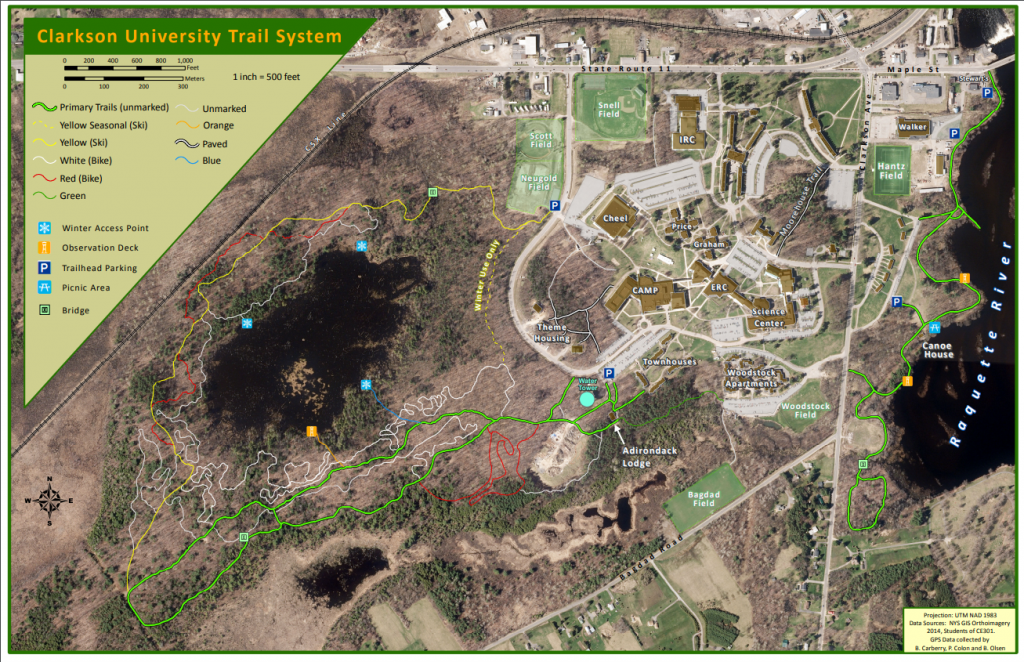Clarkson University owns and manages hundreds of acres of forested land adjacent to its hill campus, including the “Clarkson Woods” (also known as the “Back Forty” or “ROTC Woods”) and the Munter Trail along the Raquette River. Together, these sites contain a high degree of biodiversity across diverse ecosystems, including vernal pools, beaver wetlands, riparian zones, old growth and emergent forests. While the areas are used by many stakeholders, they have not had a strong management plan to balance the needs of users with the maintenance as natural and undeveloped spaces.
As part of a Spring 2019 course titled Culture and the Environment (ANTH 255) taught by Dr. Camille Frazier (Asst. Prof. Humanities and Social Sciences), undergraduate students conducted a qualitative research project on the local community’s uses and values of the Clarkson forest. The researchers interviewed Clarkson students, staff, and faculty as well as local community members. Their main findings and recommendations are included below.
The Clarkson Woods are a great community resource. The campus tree committee plans to initiate the development of a forest management plan to better conserve this resource. If you have any questions about the results from the anthropology study or the plans to move the recommendations forward please contact Alex French ( ISE Sustainability Coordinator) (afrench@clarkson.edu) or Prof. Camille Frazier (cfrazier@clarkson.edu).
Trail Maps / Improved Access Note: Snapchat or AllTrails apps can be used to track your location in the Clarkson trail network. A pdf of the trail network and current forest rules is attached.
————————————————————————————
Summary of Results
- Forest use falls into three primary categories: recreation (most common across all groups), education, and training.
- There is general agreement that better signage is required, especially clear trail maps and markers.
- Among all subject groups there is a strong sense of appreciation for the forest as a natural and undeveloped space and concern that it remain that way.
- Most respondents want to protect the forest as a natural space, but also would like to see continued (perhaps increased?) use of the forest for human activities. The researchers identify this as a potential point of conflict between maintaining the forest as an ecosystem separate from human activities and as a space that human communities can use and enjoy.
- Most respondents agree that there should be no further development of the forest such as building theme housing, parking structures, etc. However, the university should allow diverse recreational, educational, and training activities (preferably cleared in accordance with policy) and maintain the forest more generally.
- There is a need for clear rules and regulations, but the university should maintain its policy for unrestricted access so that the forest remains accessible to all.
- The forest is a resource for Clarkson affiliates as well as non-Clarkson affiliates, but there is some confusion about Clarkson’s ownership of and role in managing these spaces.
- Diverse groups use the forest and feel a stake in its protection, but most people also feel confused about which uses are permitted and whom to approach to get approval for various activities. There is a general anxiety about what is permitted/prohibited in the various forest spaces.
- In addition to the similarities between subject groups discussed in the above points, there are also a few broad differences that are visible in the individual reports. For example, community members are more likely to be familiar with the Munter Trail and refer to this space when discussing their use of Clarkson’s forested lands, but Clarkson students are more likely to mention the “back forty.” This reflects larger misconceptions about the forest among different groups: mainly, community members feel that the “back forty” is a space that only Clarkson affiliates can use, and Clarkson students are less likely to think of the Munter Trail as a campus space.
Summary of Recommendations
- Create a program/structure for maintaining the forest as natural and undeveloped space in perpetuity.
- Consider developing programming for the Clarkson and local communities to introduce more people to the forest, with the goal of creating a sustained and sustainable relationship with the space.
- Design, disseminate, and implement/enforce clear policies regarding use of the forest
- Specific issues to consider: dogs (leashed vs. unleashed); ATVs; “leave no trace” (LNT); bonfires; trails/structures for particular uses (e.g. mountain biking); process for getting approval/bringing complaints (i.e. a clear reporting structure); parties responsible for maintenance.
- Partner with clubs regarding regular maintenance and creating/enforcing policies, as this will give clubs a stake in forest management.
- Create better signage. Minimally, this should include a comprehensive trail map at the main entrance and perhaps all points of entry. Some other options to consider: 1) as part of the trail map, a key of existing signage and/or very clear indication of trail markings, distances, seasonal activities; 2) educational signs, e.g. at observation tower, signs about particular species of plants, history of area/landscapes/ecologies; 3) signs indicating policies, e.g. “leave no trace” or correct uses of the fire pit; 4) clear trail markers throughout.
- Consider new ways (e.g. activities like maple sugaring; signs about the history of particular sites such as the beaver pond) to bring more people into the forest and educate them about the space, but do so with a clear plan in mind about how to limit the possibly destructive outcome of this increased use. In other words, develop a plan to balance the twin responsibilities of using the forest as a resource for as many people as possible and maintaining the forest as an ecosystem separate from human uses and values.
